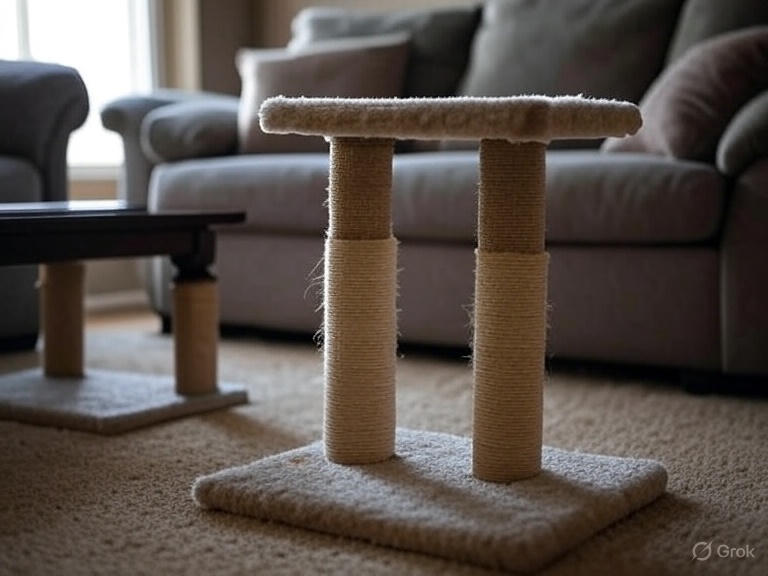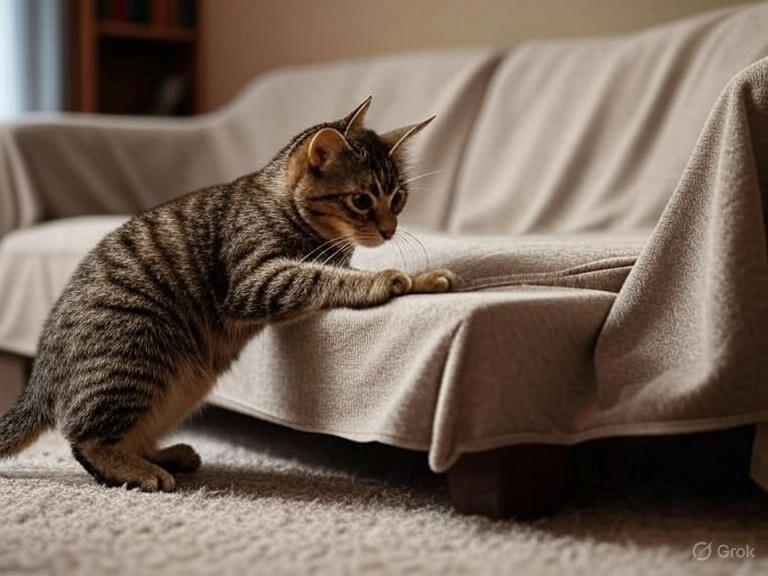How to Deter Cats from Scratching Furniture?
How to Deter Cats from Scratching Furniture: The Complete Cat Owner’s Guide
Cats bring joy, companionship, and endless entertainment to our homes. However, they also bring one particularly frustrating behavior that drives cat parents to their wit’s end: furniture scratching. Your beautiful sofa, elegant dining chairs, and expensive curtains become casualties in what feels like an endless battle against your feline friend’s natural instincts.
The good news? You can protect your furniture without declawing your cat or sacrificing your sanity. This comprehensive guide reveals proven strategies that work, helping you create a harmonious home where both you and your cat can coexist peacefully.
Why Do Cats Scratch Furniture in the First Place?
Before diving into solutions, you need to understand the driving forces behind this behavior. Cats don’t scratch your furniture out of spite or malice. They scratch because it serves multiple essential purposes in their daily routine.
First, scratching helps cats maintain healthy claws. The motion removes the outer sheaths of their nails, revealing sharp, clean claws underneath. Think of it as their version of filing their nails. This process keeps their claws in optimal condition for climbing, hunting, and self-defense.
Second, scratching serves as a form of territorial marking. Cats have scent glands in their paw pads that release pheromones when they scratch. These invisible chemical signals communicate to other cats that this territory belongs to them. Your sofa becomes a giant message board announcing your cat’s presence.
Third, scratching provides much-needed physical exercise and stress relief. The stretching motion engages muscles throughout their body, from their toes to their shoulders. After a long nap, cats often seek out scratching surfaces to work out the kinks and wake up their muscles.
Finally, scratching offers emotional benefits. The repetitive motion can be soothing and help cats process anxiety or excitement. Just like humans might tap their fingers when nervous, cats often scratch when they need to release tension.
Identifying Your Cat’s Scratching Preferences
Every cat develops unique scratching habits and preferences. Some cats prefer vertical surfaces like the arm of your couch, while others gravitate toward horizontal surfaces like your area rug. Some love rough textures like sisal rope, while others prefer smooth surfaces like leather or wood.
Observe your cat’s current scratching behavior closely. Notice which pieces of furniture they target most often. Pay attention to the time of day they scratch most frequently. Many cats engage in scratching sessions right after waking up or when they’re excited about something.
Also note the angle and height of their preferred scratching spots. Cats typically stretch up high when scratching vertical surfaces, so they need adequate height to fully extend their bodies. This observation will help you choose appropriate alternatives later.
The texture preference matters tremendously. Run your hand over the surfaces your cat currently scratches. Is the material rough, smooth, soft, or firm? This tactile information guides you toward scratching posts and pads that will actually appeal to your cat.
Strategic Scratching Post Placement
The location of scratching alternatives plays a crucial role in their success. Simply buying a scratching post and placing it in an out-of-the-way corner rarely works. Cats want convenient scratching options in the areas where they spend most of their time.
Place scratching posts near your cat’s favorite sleeping spots. Since many cats scratch immediately after waking up, having a post nearby makes it the obvious choice. If your cat loves napping on the couch, position a scratching post right next to it.
High-traffic areas also make excellent locations for scratching posts. Cats often scratch when they’re excited or when family members come home. Having scratching options in your entryway or main living areas captures these moments before they turn to your furniture.
Consider placing posts near windows where your cat watches outdoor activity. The excitement of seeing birds, squirrels, or other cats often triggers scratching behavior. A well-placed post can redirect this energy away from your window treatments.
Don’t limit yourself to just one scratching post. Multiple cats need multiple options, but even single-cat households benefit from several posts in different locations. This approach increases the likelihood that your cat will always have a convenient alternative to your furniture.
Choosing the Right Scratching Surfaces
The market offers countless scratching post options, but not all posts appeal to every cat. Success depends on matching the post characteristics to your cat’s specific preferences.
Sisal rope posts work well for cats who prefer rough textures. The natural fiber provides excellent grip and satisfying resistance when claws dig in. These posts tend to last longer than other materials because sisal holds up well to repeated scratching.
Corrugated cardboard scratchers appeal to many cats and often cost less than other options. They come in various shapes and sizes, from simple flat pads to elaborate curved designs. The downside is that cardboard creates mess as pieces flake off during use.
Carpet-covered posts might seem logical, but they can actually create problems. If your cat learns to scratch carpet on their post, they may not distinguish between the post carpet and your home’s carpeting. This can lead to unwanted carpet scratching throughout your house.
Wood posts offer a natural option that many cats enjoy. Cedar, pine, and other softwoods provide good texture for claw maintenance. Hardwood posts last longer but may be too smooth for some cats’ preferences.
Combination posts that offer multiple textures give your cat variety and help you discover their preferences. These posts might feature sisal rope on one section, carpet on another, and bare wood on a third area.
Making Furniture Less Appealing
While providing attractive alternatives, you also need to make your current furniture less appealing to scratch. This two-pronged approach accelerates the behavior change process.
Double-sided tape creates an unpleasant texture that most cats avoid. Apply strips of tape to the areas your cat typically scratches. The sticky sensation on their paws discourages return visits. Remove the tape once your cat has established new scratching habits.
Aluminum foil produces sounds and textures that many cats dislike. Covering scratched areas with foil provides immediate deterrence. However, this method works better as a temporary solution since foil doesn’t blend well with most home decor.
Citrus scents naturally repel many cats. Spray a light citrus-scented solution on problem areas, but test it first on an inconspicuous spot to ensure it won’t stain or damage your furniture. Reapply the scent regularly as it fades.
Commercial deterrent sprays designed specifically for furniture protection can be effective. These products usually combine unpleasant scents and tastes to discourage scratching and chewing. Follow the manufacturer’s instructions carefully and test on a small area first.
Plastic furniture protectors create a physical barrier while preserving your furniture’s appearance. Clear plastic guards attach to furniture arms and cushions, preventing claw damage while remaining relatively invisible.
Training Techniques That Actually Work
Positive reinforcement proves far more effective than punishment when modifying cat behavior. Cats respond better to rewards for good behavior than to scolding for bad behavior.
Reward your cat immediately when you catch them using their scratching post. Offer treats, praise, or brief play sessions to reinforce this desired behavior. Timing matters tremendously – the reward must come within seconds of the scratching to create a clear connection.
Never punish your cat for scratching furniture. Yelling, spraying with water, or other negative responses create stress and anxiety, which often leads to more problematic behaviors. Punishment also damages your relationship with your cat.
Redirect scratching behavior instead of stopping it entirely. When you see your cat approaching forbidden furniture, gently guide them to their scratching post. Make the post more appealing by rubbing it with catnip or playing with a toy near it.
Interactive play sessions can reduce furniture scratching by providing physical and mental stimulation. Tired, satisfied cats scratch less destructively. Schedule regular play times, especially before meals and bedtime.
Consistency from all family members ensures faster training success. Everyone in the household needs to follow the same approach. Mixed messages confuse your cat and slow progress.
Environmental Enrichment Solutions
Bored cats often engage in destructive behaviors, including excessive furniture scratching. Enriching your cat’s environment addresses the root cause of many behavioral issues.
Puzzle feeders and food-dispensing toys provide mental stimulation during meal times. These devices slow down eating while engaging your cat’s problem-solving abilities. A mentally tired cat is less likely to seek stimulation through furniture destruction.
Window perches and cat trees offer elevated spaces that satisfy your cat’s desire to survey their territory. These additions also provide built-in scratching surfaces in appealing locations.
Regular rotation of toys prevents boredom and maintains your cat’s interest. Store some toys away and rotate them weekly to keep things fresh and exciting.
Interactive toys that mimic prey movements trigger your cat’s hunting instincts in positive ways. Feather wands, laser pointers, and motorized mice provide outlets for natural behaviors.
Catnip and silvervine can make scratching posts more attractive to cats who respond to these herbs. Sprinkle dried herbs on posts or use spray versions to refresh the appeal regularly.
Addressing Stress-Related Scratching
Cats often increase scratching behavior when they feel stressed or anxious. Identifying and addressing stress sources can significantly reduce furniture damage.
Changes in routine, new pets, moving homes, or construction noise can trigger stress responses in sensitive cats. During stressful periods, provide extra scratching options and be patient with temporary increases in scratching behavior.
Pheromone diffusers release synthetic versions of calming cat pheromones that can reduce stress-related behaviors. These plug-in devices work continuously to create a more relaxed environment.
Safe spaces where your cat can retreat when overwhelmed help manage stress levels. Create quiet areas with comfortable bedding, water, and scratching options where your cat won’t be disturbed.
Multiple cats in one household may scratch more due to territorial disputes. Ensure each cat has access to their own resources, including separate scratching posts, to reduce competition and stress.
Quick Fixes for Immediate Relief
While implementing long-term solutions, you need immediate protection for your furniture. These temporary measures buy you time while training progresses.
Furniture covers provide instant protection and can be easily removed when guests visit. Look for covers specifically designed for pet owners that resist claw damage.
Nail caps create a temporary solution by covering your cat’s claws with soft plastic tips. These caps fall off naturally as the nail grows and need regular replacement. Not all cats tolerate the application process.
Regular nail trimming reduces the damage potential of scratching behavior. Trim just the sharp tips every 2-3 weeks using proper cat nail clippers. Start slowly if your cat isn’t used to nail trims.
Blocking access to preferred scratching spots forces your cat to find alternatives. Move furniture temporarily or use barriers while you establish new scratching habits.
Advanced Solutions for Persistent Problems
Some cats prove more challenging to redirect than others. These advanced techniques help with stubborn scratching problems.
Motion-activated deterrents use sensors to trigger unpleasant stimuli when cats approach forbidden areas. These devices work even when you’re not home, providing consistent reinforcement.
Professional animal behaviorists can assess complex scratching problems and develop customized solutions. Consider professional help if multiple approaches haven’t yielded results after several weeks.
Anti-anxiety medications prescribed by veterinarians can help cats whose scratching stems from severe stress or anxiety disorders. This option should only be considered after other methods have failed and under professional guidance.
Environmental modifications like additional vertical spaces, hiding spots, or territorial markers can address underlying causes of excessive scratching in multi-cat households.
Long-Term Maintenance Strategies
Successfully deterring furniture scratching requires ongoing attention and maintenance. These strategies help maintain your success over time.
Regular inspection of scratching posts ensures they remain appealing to your cat. Replace worn posts before they become ineffective. Refresh sisal rope or cardboard surfaces as needed.
Continued positive reinforcement maintains good scratching habits even after initial training succeeds. Occasional treats and praise for using appropriate scratching surfaces reinforce the behavior.
Monitoring for new scratching locations helps you address problems before they become established habits. Cats may develop new preferences as they age or when household circumstances change.
Seasonal adjustments account for changes in your cat’s routine or environment. Indoor heating during winter or increased outdoor activity during spring may affect scratching patterns.

Creating a Scratch-Friendly Home
The ultimate goal involves creating an environment where your cat’s natural scratching needs are met without destroying your furniture. This balance requires thoughtful planning and ongoing attention.
Design your space with both human and feline needs in mind. Attractive scratching posts that complement your decor make it easier to provide adequate options throughout your home.
Quality investments in durable scratching surfaces save money long-term and provide better satisfaction for your cat. Cheap posts that wobble or fall over quickly become ignored.
Family education ensures everyone understands and supports your cat’s need to scratch. Teaching children proper interaction with scratching posts and furniture protection helps maintain household rules.
Your cat’s scratching behavior doesn’t have to destroy your furniture or your sanity. With patience, consistency, and the right approach, you can redirect this natural behavior toward appropriate outlets. The key lies in understanding your cat’s individual preferences, providing appealing alternatives, and maintaining positive reinforcement for good choices.
Remember that success takes time. Most cats need several weeks to establish new scratching habits, so don’t get discouraged if you don’t see immediate results. Stay consistent with your approach, and celebrate small victories along the way.
The investment in proper scratching solutions pays dividends in preserved furniture, reduced stress, and a happier relationship with your feline companion. Your cat gets to express their natural instincts, and you get to keep your furniture intact. That’s a win-win solution worth pursuing.Cats bring joy, companionship, and endless entertainment to our homes. However, they also bring one particularly frustrating behavior that drives cat parents to their wit’s end: furniture scratching. Your beautiful sofa, elegant dining chairs, and expensive curtains become casualties in what feels like an endless battle against your feline friend’s natural instincts.
The good news? You can protect your furniture without declawing your cat or sacrificing your sanity. This comprehensive guide reveals proven strategies that work, helping you create a harmonious home where both you and your cat can coexist peacefully.
Why Do Cats Scratch Furniture in the First Place?
Before diving into solutions, you need to understand the driving forces behind this behavior. Cats don’t scratch your furniture out of spite or malice. They scratch because it serves multiple essential purposes in their daily routine.
First, scratching helps cats maintain healthy claws. The motion removes the outer sheaths of their nails, revealing sharp, clean claws underneath. Think of it as their version of filing their nails. This process keeps their claws in optimal condition for climbing, hunting, and self-defense.
Second, scratching serves as a form of territorial marking. Cats have scent glands in their paw pads that release pheromones when they scratch. These invisible chemical signals communicate to other cats that this territory belongs to them. Your sofa becomes a giant message board announcing your cat’s presence.
Third, scratching provides much-needed physical exercise and stress relief. The stretching motion engages muscles throughout their body, from their toes to their shoulders. After a long nap, cats often seek out scratching surfaces to work out the kinks and wake up their muscles.
Finally, scratching offers emotional benefits. The repetitive motion can be soothing and help cats process anxiety or excitement. Just like humans might tap their fingers when nervous, cats often scratch when they need to release tension.
Identifying Your Cat’s Scratching Preferences
Every cat develops unique scratching habits and preferences. Some cats prefer vertical surfaces like the arm of your couch, while others gravitate toward horizontal surfaces like your area rug. Some love rough textures like sisal rope, while others prefer smooth surfaces like leather or wood.
Observe your cat’s current scratching behavior closely. Notice which pieces of furniture they target most often. Pay attention to the time of day they scratch most frequently. Many cats engage in scratching sessions right after waking up or when they’re excited about something.
Also note the angle and height of their preferred scratching spots. Cats typically stretch up high when scratching vertical surfaces, so they need adequate height to fully extend their bodies. This observation will help you choose appropriate alternatives later.
The texture preference matters tremendously. Run your hand over the surfaces your cat currently scratches. Is the material rough, smooth, soft, or firm? This tactile information guides you toward scratching posts and pads that will actually appeal to your cat.
Strategic Scratching Post Placement
The location of scratching alternatives plays a crucial role in their success. Simply buying a scratching post and placing it in an out-of-the-way corner rarely works. Cats want convenient scratching options in the areas where they spend most of their time.
Place scratching posts near your cat’s favorite sleeping spots. Since many cats scratch immediately after waking up, having a post nearby makes it the obvious choice. If your cat loves napping on the couch, position a scratching post right next to it.
High-traffic areas also make excellent locations for scratching posts. Cats often scratch when they’re excited or when family members come home. Having scratching options in your entryway or main living areas captures these moments before they turn to your furniture.
Consider placing posts near windows where your cat watches outdoor activity. The excitement of seeing birds, squirrels, or other cats often triggers scratching behavior. A well-placed post can redirect this energy away from your window treatments.
Don’t limit yourself to just one scratching post. Multiple cats need multiple options, but even single-cat households benefit from several posts in different locations. This approach increases the likelihood that your cat will always have a convenient alternative to your furniture.
Choosing the Right Scratching Surfaces
The market offers countless scratching post options, but not all posts appeal to every cat. Success depends on matching the post characteristics to your cat’s specific preferences.
Sisal rope posts work well for cats who prefer rough textures. The natural fiber provides excellent grip and satisfying resistance when claws dig in. These posts tend to last longer than other materials because sisal holds up well to repeated scratching.
Corrugated cardboard scratchers appeal to many cats and often cost less than other options. They come in various shapes and sizes, from simple flat pads to elaborate curved designs. The downside is that cardboard creates mess as pieces flake off during use.
Carpet-covered posts might seem logical, but they can actually create problems. If your cat learns to scratch carpet on their post, they may not distinguish between the post carpet and your home’s carpeting. This can lead to unwanted carpet scratching throughout your house.
Wood posts offer a natural option that many cats enjoy. Cedar, pine, and other softwoods provide good texture for claw maintenance. Hardwood posts last longer but may be too smooth for some cats’ preferences.
Combination posts that offer multiple textures give your cat variety and help you discover their preferences. These posts might feature sisal rope on one section, carpet on another, and bare wood on a third area.
Making Furniture Less Appealing
While providing attractive alternatives, you also need to make your current furniture less appealing to scratch. This two-pronged approach accelerates the behavior change process.
Double-sided tape creates an unpleasant texture that most cats avoid. Apply strips of tape to the areas your cat typically scratches. The sticky sensation on their paws discourages return visits. Remove the tape once your cat has established new scratching habits.
Aluminum foil produces sounds and textures that many cats dislike. Covering scratched areas with foil provides immediate deterrence. However, this method works better as a temporary solution since foil doesn’t blend well with most home decor.
Citrus scents naturally repel many cats. Spray a light citrus-scented solution on problem areas, but test it first on an inconspicuous spot to ensure it won’t stain or damage your furniture. Reapply the scent regularly as it fades.
Commercial deterrent sprays designed specifically for furniture protection can be effective. These products usually combine unpleasant scents and tastes to discourage scratching and chewing. Follow the manufacturer’s instructions carefully and test on a small area first.
Plastic furniture protectors create a physical barrier while preserving your furniture’s appearance. Clear plastic guards attach to furniture arms and cushions, preventing claw damage while remaining relatively invisible.
Training Techniques That Actually Work
Positive reinforcement proves far more effective than punishment when modifying cat behavior. Cats respond better to rewards for good behavior than to scolding for bad behavior.
Reward your cat immediately when you catch them using their scratching post. Offer treats, praise, or brief play sessions to reinforce this desired behavior. Timing matters tremendously – the reward must come within seconds of the scratching to create a clear connection.
Never punish your cat for scratching furniture. Yelling, spraying with water, or other negative responses create stress and anxiety, which often leads to more problematic behaviors. Punishment also damages your relationship with your cat.
Redirect scratching behavior instead of stopping it entirely. When you see your cat approaching forbidden furniture, gently guide them to their scratching post. Make the post more appealing by rubbing it with catnip or playing with a toy near it.
Interactive play sessions can reduce furniture scratching by providing physical and mental stimulation. Tired, satisfied cats scratch less destructively. Schedule regular play times, especially before meals and bedtime.
Consistency from all family members ensures faster training success. Everyone in the household needs to follow the same approach. Mixed messages confuse your cat and slow progress.
Environmental Enrichment Solutions
Bored cats often engage in destructive behaviors, including excessive furniture scratching. Enriching your cat’s environment addresses the root cause of many behavioral issues.
Puzzle feeders and food-dispensing toys provide mental stimulation during meal times. These devices slow down eating while engaging your cat’s problem-solving abilities. A mentally tired cat is less likely to seek stimulation through furniture destruction.
Window perches and cat trees offer elevated spaces that satisfy your cat’s desire to survey their territory. These additions also provide built-in scratching surfaces in appealing locations.
Regular rotation of toys prevents boredom and maintains your cat’s interest. Store some toys away and rotate them weekly to keep things fresh and exciting.
Interactive toys that mimic prey movements trigger your cat’s hunting instincts in positive ways. Feather wands, laser pointers, and motorized mice provide outlets for natural behaviors.
Catnip and silvervine can make scratching posts more attractive to cats who respond to these herbs. Sprinkle dried herbs on posts or use spray versions to refresh the appeal regularly.
Addressing Stress-Related Scratching
Cats often increase scratching behavior when they feel stressed or anxious. Identifying and addressing stress sources can significantly reduce furniture damage.
Changes in routine, new pets, moving homes, or construction noise can trigger stress responses in sensitive cats. During stressful periods, provide extra scratching options and be patient with temporary increases in scratching behavior.
Pheromone diffusers release synthetic versions of calming cat pheromones that can reduce stress-related behaviors. These plug-in devices work continuously to create a more relaxed environment.
Safe spaces where your cat can retreat when overwhelmed help manage stress levels. Create quiet areas with comfortable bedding, water, and scratching options where your cat won’t be disturbed.
Multiple cats in one household may scratch more due to territorial disputes. Ensure each cat has access to their own resources, including separate scratching posts, to reduce competition and stress.
Quick Fixes for Immediate Relief
While implementing long-term solutions, you need immediate protection for your furniture. These temporary measures buy you time while training progresses.
Furniture covers provide instant protection and can be easily removed when guests visit. Look for covers specifically designed for pet owners that resist claw damage.
Nail caps create a temporary solution by covering your cat’s claws with soft plastic tips. These caps fall off naturally as the nail grows and need regular replacement. Not all cats tolerate the application process.
Regular nail trimming reduces the damage potential of scratching behavior. Trim just the sharp tips every 2-3 weeks using proper cat nail clippers. Start slowly if your cat isn’t used to nail trims.
Blocking access to preferred scratching spots forces your cat to find alternatives. Move furniture temporarily or use barriers while you establish new scratching habits.
Advanced Solutions for Persistent Problems
Some cats prove more challenging to redirect than others. These advanced techniques help with stubborn scratching problems.
Motion-activated deterrents use sensors to trigger unpleasant stimuli when cats approach forbidden areas. These devices work even when you’re not home, providing consistent reinforcement.
Professional animal behaviorists can assess complex scratching problems and develop customized solutions. Consider professional help if multiple approaches haven’t yielded results after several weeks.
Anti-anxiety medications prescribed by veterinarians can help cats whose scratching stems from severe stress or anxiety disorders. This option should only be considered after other methods have failed and under professional guidance.
Environmental modifications like additional vertical spaces, hiding spots, or territorial markers can address underlying causes of excessive scratching in multi-cat households.
Long-Term Maintenance Strategies
Successfully deterring furniture scratching requires ongoing attention and maintenance. These strategies help maintain your success over time.
Regular inspection of scratching posts ensures they remain appealing to your cat. Replace worn posts before they become ineffective. Refresh sisal rope or cardboard surfaces as needed.
Continued positive reinforcement maintains good scratching habits even after initial training succeeds. Occasional treats and praise for using appropriate scratching surfaces reinforce the behavior.
Monitoring for new scratching locations helps you address problems before they become established habits. Cats may develop new preferences as they age or when household circumstances change.
Seasonal adjustments account for changes in your cat’s routine or environment. Indoor heating during winter or increased outdoor activity during spring may affect scratching patterns.
Creating a Scratch-Friendly Home
The ultimate goal involves creating an environment where your cat’s natural scratching needs are met without destroying your furniture. This balance requires thoughtful planning and ongoing attention.
Design your space with both human and feline needs in mind. Attractive scratching posts that complement your decor make it easier to provide adequate options throughout your home.
Quality investments in durable scratching surfaces save money long-term and provide better satisfaction for your cat. Cheap posts that wobble or fall over quickly become ignored.
Family education ensures everyone understands and supports your cat’s need to scratch. Teaching children proper interaction with scratching posts and furniture protection helps maintain household rules.
Your cat’s scratching behavior doesn’t have to destroy your furniture or your sanity. With patience, consistency, and the right approach, you can redirect this natural behavior toward appropriate outlets. The key lies in understanding your cat’s individual preferences, providing appealing alternatives, and maintaining positive reinforcement for good choices.
Remember that success takes time. Most cats need several weeks to establish new scratching habits, so don’t get discouraged if you don’t see immediate results. Stay consistent with your approach, and celebrate small victories along the way.
The investment in proper scratching solutions pays dividends in preserved furniture, reduced stress, and a happier relationship with your feline companion. Your cat gets to express their natural instincts, and you get to keep your furniture intact. That’s a win-win solution worth pursuing.







